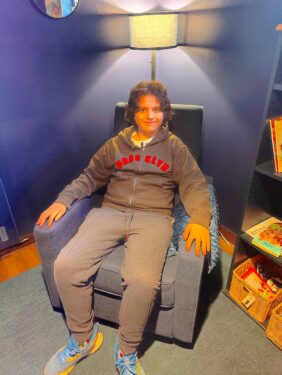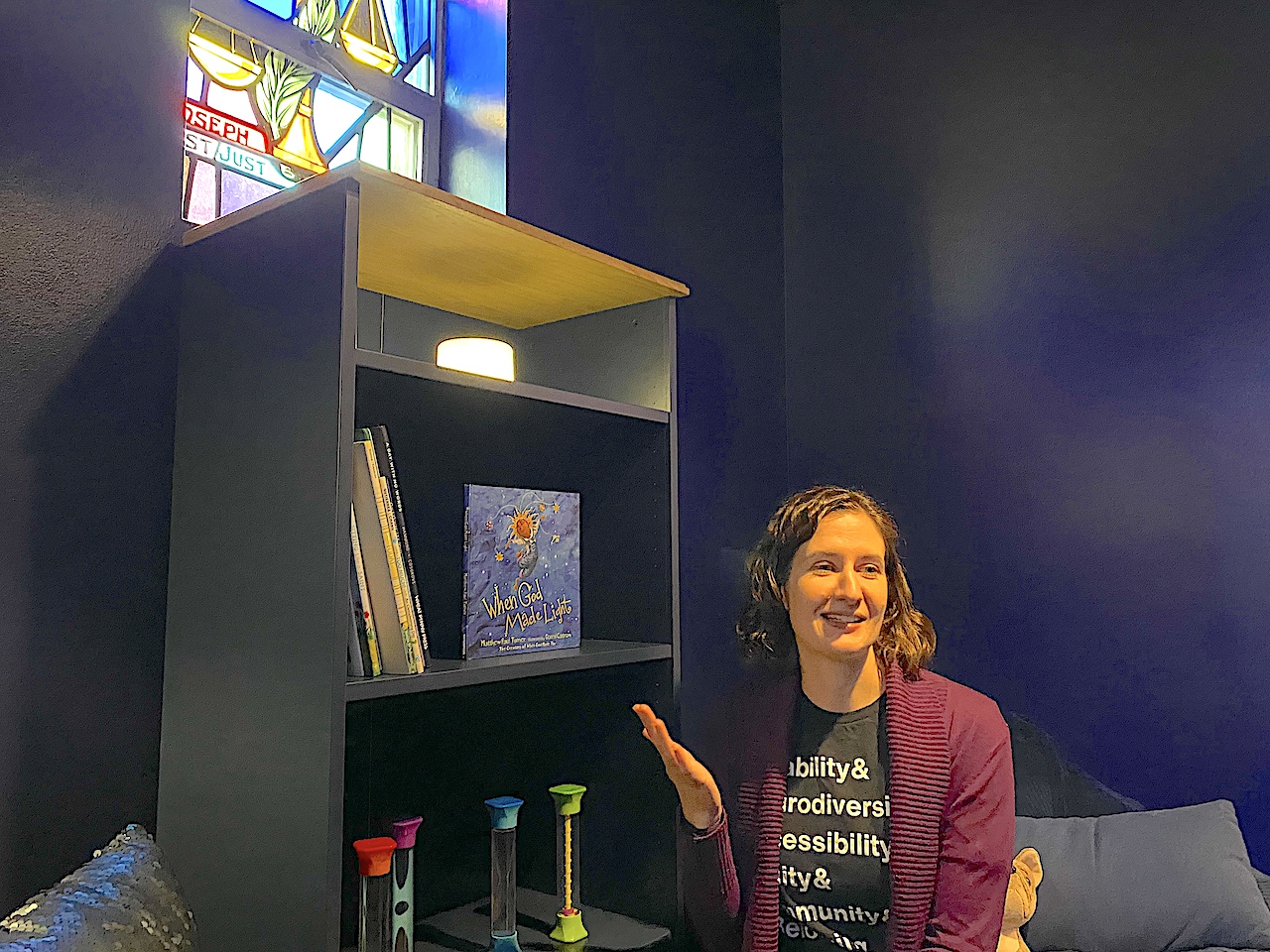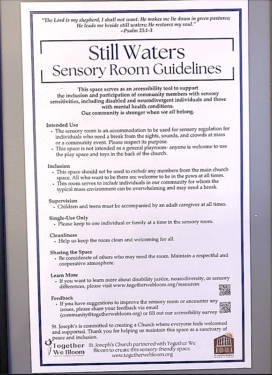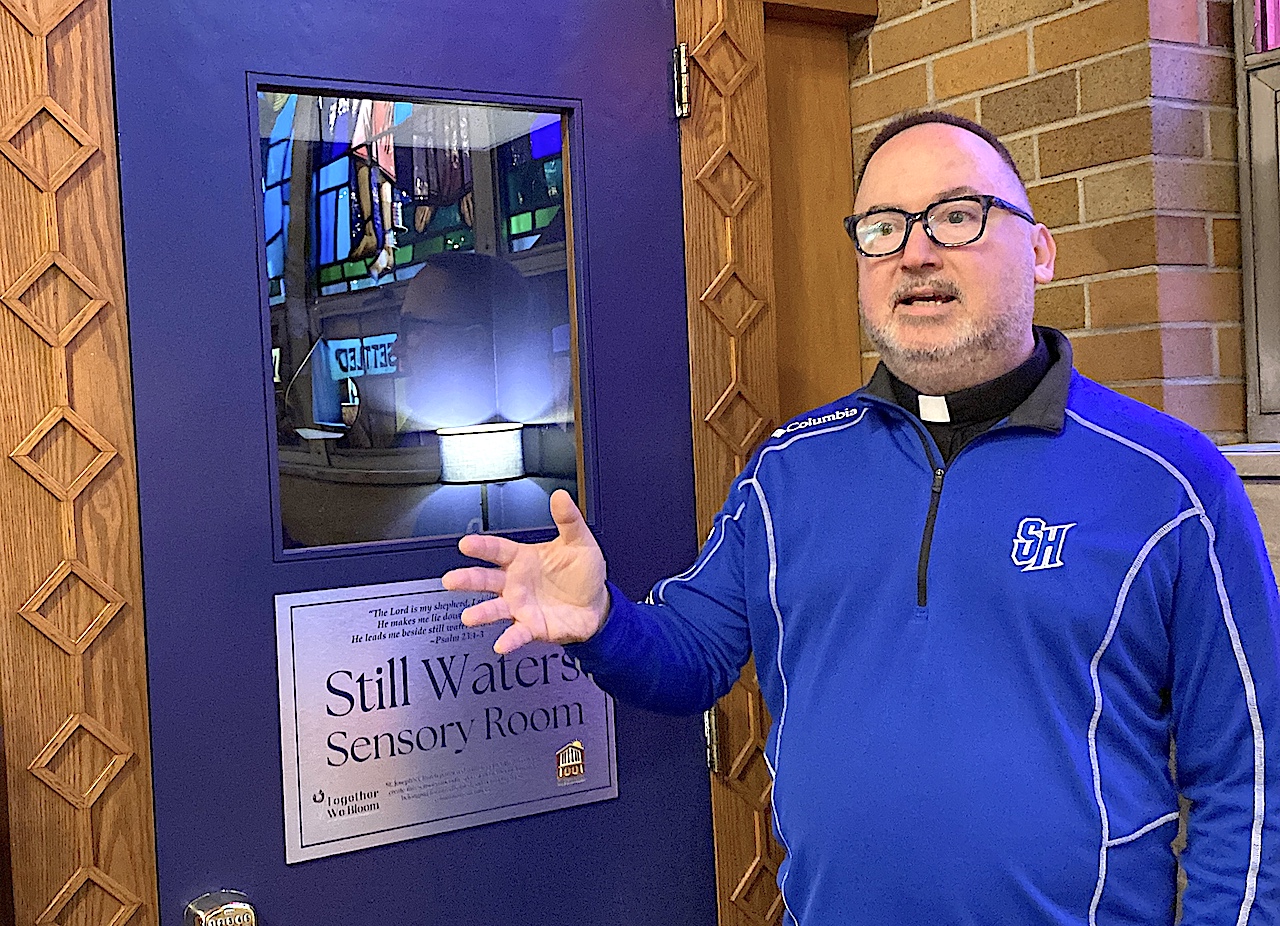The Big Apple is going green! Starting Tuesday, residents have to start composting – separating food waste from their normal trash or they’ll face a fine. But as Currents News’ Katie Vasquez reports, the new mandate is a piece of cake for one Brooklyn parishioner.
Archives
Catholic News Headlines for Monday 3/31/2025
There are nearly 40 churches on the Diocese of Brooklyn’s Lenten Pilgrimage route. One woman is on a mission to visit them all before Easter Sunday.
It’s been a week since Pope Francis was released from Gemelli Hospital, but he’s not quite ready to make any public appearances.
Relics of Blessed Carlo Acutis are reportedly being sold on the black market – auctioning them off goes against the laws of the Catholic Church.
Parishioner Vows To Visit Every Lenten Pilgrimage Stop In the Diocese of Brooklyn
By Katie Vasquez and Paula Katinas
BENSONHURST — Prayer, fasting, and almsgiving are the three pillars of Lent, but Michele Guerrier has embraced a fourth for herself — the Diocesan Lenten Pilgrimage.
Now in its third year, the Diocese of Brooklyn’s Lenten Pilgrimage runs from March 6 to April 15. During that time, the diocese designates a different church each day for the faithful to attend Mass, pray the rosary, and spend time with the Blessed Sacrament.
Guerrier, a retired probation officer from East Flatbush, has participated each year, crisscrossing Brooklyn and Queens to visit the various churches along the pilgrimage route.
When The Tablet caught up with her on the morning of March 28, she had arrived for Mass at St. Athanasius Church in Bensonhurst, the pilgrimage stop for that day. As of that day, Guerrier had made every stop along the route — 21 churches so far — and planned to visit all 37 churches designated for the pilgrimage.
“This pilgrimage has become my fourth pillar for Lent. It’s amazing,” she said.
The visit marked the first time she had ever set foot in St. Athanasius Church. Guerrier said she participates in the pilgrimage because Jesus Christ is the center of everything.
“It is the Eucharist that makes me Catholic,” she explained. “So to be able to go every day somewhere and just spend that quality time with Jesus just reaffirms my resolve. I will always be Catholic because of the Eucharist.”
She also said she relishes the opportunity to visit other churches in the diocese.
“This diocese has the most beautiful churches, and we tend to stay in our parish home and don’t realize what we have out there,” said Guerrier, who is a parishioner of St. Therese of Lisieux Church in East Flatbush.
Upon entering St. Athanasius Church, she pulled out her cell phone and used the Diocesan Lenten Pilgrimage app created by DeSales Media Group — the ministry that produces The Tablet — to check in. The app has become a handy tool for Lenten pilgrims, particularly senior citizens, she said.
“Some people who never knew how to use their phone now have learned by using the app — how to use their phone, upload apps and do wonderful things with pictures,” Guerrier explained.
At each church Guerrier visits, she looks for something that makes that church unique.
“I try to see what draws me the most, what sparks my attention,” she said, “and I take pictures, and usually there’s a word or something that will remain with me.”
Guerrier, who is active in the Haitian Apostolate and the Vicariate Office of Black Catholic Concerns, also said part of the joy of being a pilgrim is getting to meet fellow Catholics of all races and nationalities as she travels throughout the diocese.
“We are the Diocese of Immigrants. We are family in this diocese,” she said.
Even if parishioners are not able to participate in person, they can still join the community online through the app to see all of the pilgrimage stops and even make prayer requests. Participants can get more information by visiting lent.dioceseofbrooklyn.org/.
Packed Corona, Queens Church Prays for Dozens of Soon-to-be Parishioners
By Currents News
Hundreds at Our Lady of Sorrows Church in Corona, Queens prayed for dozens of soon-to-be parishioners.
The church was full on Sunday March 30 as 60 people took part in their second rite of scrutiny, where the elect and godparents step forward and the parish prays for them.
Bishop Robert Brennan celebrated the ancient rite, which is meant to spiritually prepare the faithful in the weeks leading up to their baptism at the Easter Vigil.
While these men and women are about to finish their faith education journey, more than 300 religious students completed a milestone in theirs.
The children dropped off envelopes at the end of the Mass to mark their hours of church attendance over the last few weeks. It is an important step before they receive the sacrament of Confirmation.
Bishop Robert Brennan Offers Lenten Message of Encouragement
By Currents News
Easter is fast approaching, and Catholics celebrated the fourth Sunday of Lent. On his X account, Bishop Robert Brennan offered a message of encouragement to his flock.
“You know, remember at the beginning of Lent we heard the Temptations? What was the devil trying to do?” The Brooklyn shepherd asks. “Convince Jesus that he wasn’t really the beloved son of God. But Jesus knew who he was, and he reminds us of who we are. Friends, we’re at this midpoint in Lent. In these remaining weeks let’s recall the great love of God and hear the call to conversion not because we’re terrible people who are disappointing God because we are beloved sons and daughters of the father who loves us beyond measure.”
Bishop Brennan posts a Sunday reflection every week. Be sure to follow him online here.
Long Island City Lenten Pilgrimage Stop’s Special Connection to Saint Pope John Paul II
By Currents News
Lent is officially halfway through and the Diocese of Brooklyn is now more than halfway through its Lenten pilgrimage.
Dozens have been visiting different churches in Brooklyn and Queens leading up to the Easter Triduum. Monday’s stop actually had a papal connection.
Bishop Robert Brennan celebrated the Mass at St. Mary’s Church in Long Island City, Queens at the very altar Saint John Paul II used when he celebrated Mass at Aqueduct Racetrack in 1995.
After Mass, parishioners then prayed the Stations of the Cross.
Brooklyn Parishioner Set to Make Every Stop on Diocese of Brooklyn Lenten Pilgrimage
By Currents News
This Lent, one Brooklyn parishioner is on a mission to make every stop along the Diocese of Brooklyn’s pilgrimage route.
She’s reconnecting with friends and her faith along the way as she visits nearly 40 churches.
Uber Driver Travels Road to Redemption by Becoming Catholic
By Katie Vasquez
Christopher Pena spends his days picking up passengers across New York City’s five boroughs.
At one point, his life was headed on a one way street too, but that one was to nowhere.
“I was a drug addict, yes,” he tells Currents News. “I used drugs. Cocaine, pills. I meet the wrong people, and that was a bad experience.”
The Bronx resident decided he needed to shift his mindset.
While he got clean two-and-a-half years ago, he still felt like something was missing.
That’s when he let Jesus take the wheel.
“The reason why I came to church, because I want to change my life,” he explains. “I want to find something like identity. I want to connect more with God, spirituality, and physically meet different people.”
He grew up in the Dominican Republic and moved to New York when he was 16, attending both Catholic Masses and evangelical Christian services.
A friend suggested St. Rita Church in East New York, Brooklyn where he felt instantly at peace.
“I like to be here. the people, they treat me good,” says Pena,” who is now a parishioner there and taking the next step in his spiritual journey: he’s about to be baptized into the Catholic faith.
It’s a step he’s taking that he hopes will provide him with a clean slate.
“I want to be more different, be more faithful, do something different for my life, start my life again,” he says.
Pena prays that his experiences can be an example to others: “There’s hope and maybe I can change the mind to come to the church and do the right thing, and start believing more in Jesus.”
And he continues driving forward, knowing that God is right beside him.
Catholic News Headlines for Friday 3/28/2025
One NJ Church is creating space for neurodivergent parishioners to participate more fully in Mass.
The Lenten Pilgrimage continues…and in droves! The stop that has more than 1,000 pilgrims in Queens.
The Vatican releases its Holy Week schedule, but it’s still unclear what Pope Francis will celebrate.
And the story of an Uber driver, who is choosing the road to redemption. He’s becoming Catholic.
New Jersey Church Builds Sensory Room for Parishioners With Disabilities
By Bill Miller and Jessica Easthope
In the Gospel, Jesus told his disciples to stop preventing children from approaching him. “Let the children come to me,” he said, and added, “for the kingdom of God belongs to such as these(Mark 10:13-14).”
Father Jim Worth, pastor of St. Joseph Parish in Maplewood, N.J., takes that scripture seriously. So did parishioners who joined him to ensure accessibility for all children, especially those with disabilities.
To that end, Father Worth and the parishioners converted a former confessional-turned-storage space in the back of the church into the Still Waters Sensory Room.
Here, children with neurodivergent disabilities, like autism or ADHD, can spend a few moments during Mass if they ever feel a sensory overload.
The room is painted a calming dark blue. Amenities include a beanbag chair, a rocker, religious-themed storybooks, and “stim” toys that occupy a child’s mind and fingers.
Its name comes from Psalm 23:1-3, in which King David wrote, “The Lord is my shepherd; there is nothing I lack. In green pastures he makes me lie down; to still waters he leads me; he restores my soul.”
But it’s not just for little kids.
Percy Losardo, 14, has autism. He struggled to sit still in the pews, so he stayed home while the rest of his family went to Mass. That changed when the parish opened the Still Waters Sensory Room on Dec. 8.

“I like that I can go to the room, and it’s quiet,” Percy said. “I can relax and take a break. I don’t have to leave church.”
Father Worth, now in his 10th year as pastor, has led the parish in other endeavors aimed at achieving inclusivity, including a basketball program for people with autism.
He recalled how last year, parishioner Kim Takacs, a speech-language pathologist, invited him to a community Zoom meeting to discuss how to improve accessibility for all.
Takacs is the founder and executive director of the Maplewood-based organization, Together We Bloom. During the Zoom call, Takacs described how sensory rooms were helping disabled communities.
Father Worth said he immediately thought of the packed storage space and offered it for a sensory room. Next, he met with Takacs and the Together We Bloom board to plan the renovation. The expense, he noted, was minimal.
“Some people volunteered,” he said. “It was very grassroots. I actually got dirty getting rid of all the stuff that had piled into this room.”
Together, We Bloom helps children with disabilities and their families achieve “equitable access through connection, community, and communication,” Takacs said.
“The way that we do that,” she said, “is by making the community more accessible, more accepting, and more appreciative of the diversity that disability and neurodivergence brings to our communities.”

Neurodivergent refers to people whose brains process information differently than what is considered typical or “neurotypical.”
Takacs explained that her work with disabled people is “very much based on a call to social justice.” The nonprofit’s work is focused on “disability justice,” she said.
“It’s Catholic social teaching — this idea that we all belong,” Takacs said. “And all of our well-being, all of our sense of belonging, is very much tied to everybody feeling welcome and joining in solidarity and the common good.”
Takacs said the sensory room was expertly designed by Janelle Gera, the chair of the board for Together We Bloom, who has autism and ADHD. Takacs also praised the pastor.

“It takes work to actively dismantle barriers, to make a place truly welcoming, and to really foster belonging,” Takacs said. “That’s what Father Jim has done by creating this space and all of the other things.”
For example, just outside Still Waters Sensory Room is a play center — the kind that usually appears in the nursery or a Sunday school classroom. Father Worth said the play area for “neurotypical” children shows that all are indeed welcome on Sunday.
“If you come to a 9 o’clock Mass, you hear kids all the time,” Father Worth said. “And it makes me happy because Mark’s Gospel says, ‘Let the children come to me.’ I’d rather them be here than in a crying room.”
Meanwhile, Father Worth said that the sensory room “lets a parent feel good about bringing their children to Mass.”
“I’ve had mothers come up to me with tears in their eyes saying, ‘You know what? Now I can come back to Mass.’ ”
Among the grateful parents is Pavitra Makam. She and her husband, Antony, used to bring their young children — son Kai, 9, and daughter Rumi, 5 — in shifts to Mass.
Their son has anxiety and ADHD, while their daughter has a rare genetic disorder that makes sitting uncomfortable in the wooden pews, she said.
Makam said Kai tends to “mask” his anxieties to get through the day, so he faces them in silence. But the sensory room, she added, gives him an outlet to manage stress.
“He gets very stressed and antsy,” she said. “So now he can come into the room, use the fidget toys, calm himself, reset, and then go back to Mass.”
Makam said belonging to St. Joseph Parish has been an “amazing experience.”
“They are so inclusive here,” she said. “And it feels so nice to be able to come and worship together and not have to separate our family.”
